The Cross-Calibration of Spectral Radiances and Cross-Validation of CO2 Estimates from GOSAT and OCO-2
Abstract
:1. Introduction
1.1. CO2 Monitoring from Space
1.2. Outline of Instrument Specifications and Observation Methods
1.3. Objectives of On-Orbit Cross-Comparisons
2. Analytical Method
2.1. Spectral Radiance Data and Retrieved XCO2 for the Inter-Comparison
2.2. Selection of Geometrically Matched-Up Data
3. Spectral Radiance Inter-Comparison
3.1. Methodology of Spectral Radiance Inter-Comparison
3.2. Spectral Radiance Inter-Comparison Result
4. Retrieved XCO2 Product Inter-Comparison
4.1. Methodology of Retrievals Inter-Comparison
4.2. Retrieved XCO2 Inter-Comparison Result
5. Discussion
5.1. Error in BRDF Correction
5.2. Remaining Issues and Possible Solutions
6. Conclusions
Acknowledgments
Author Contributions
Conflicts of Interest
Appendix A

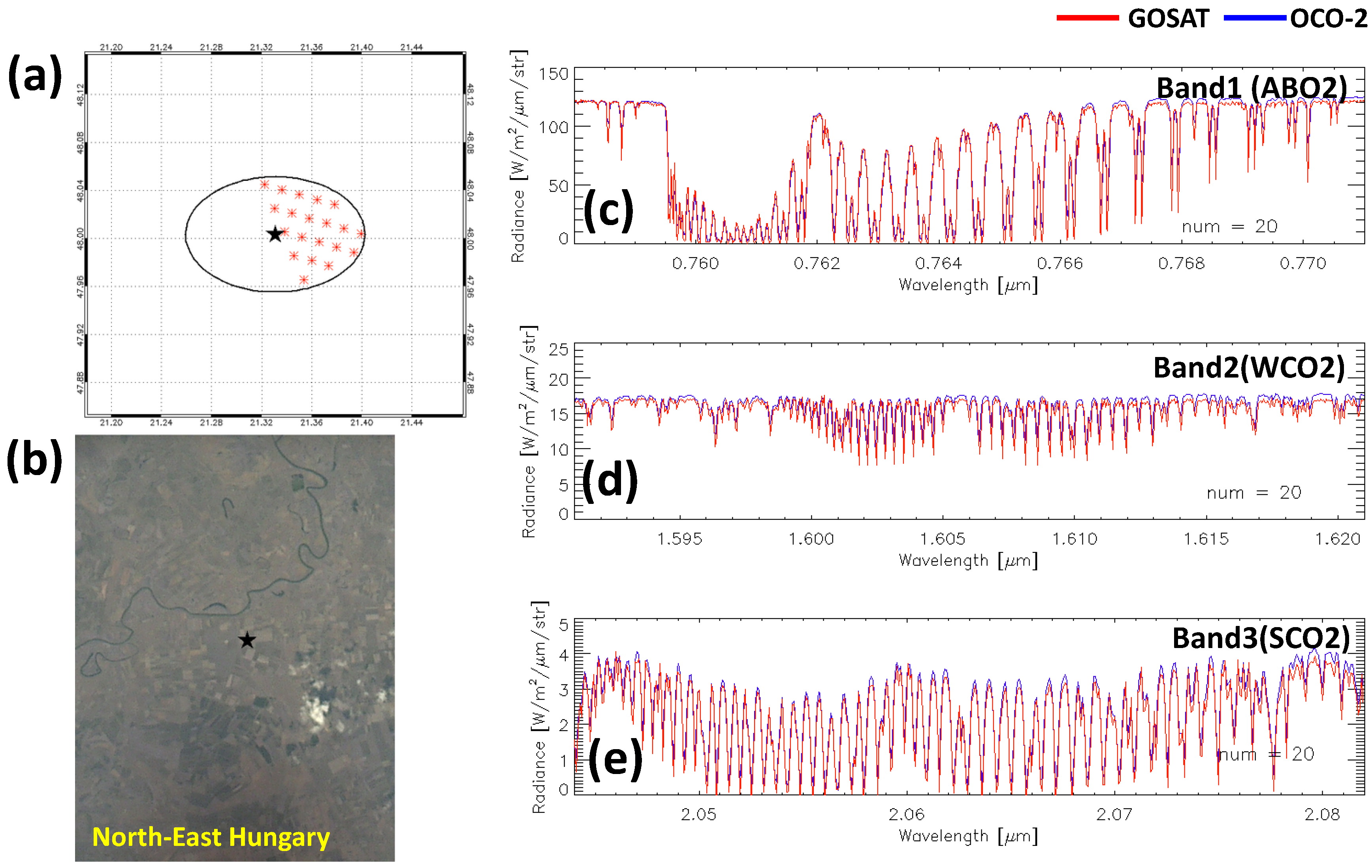
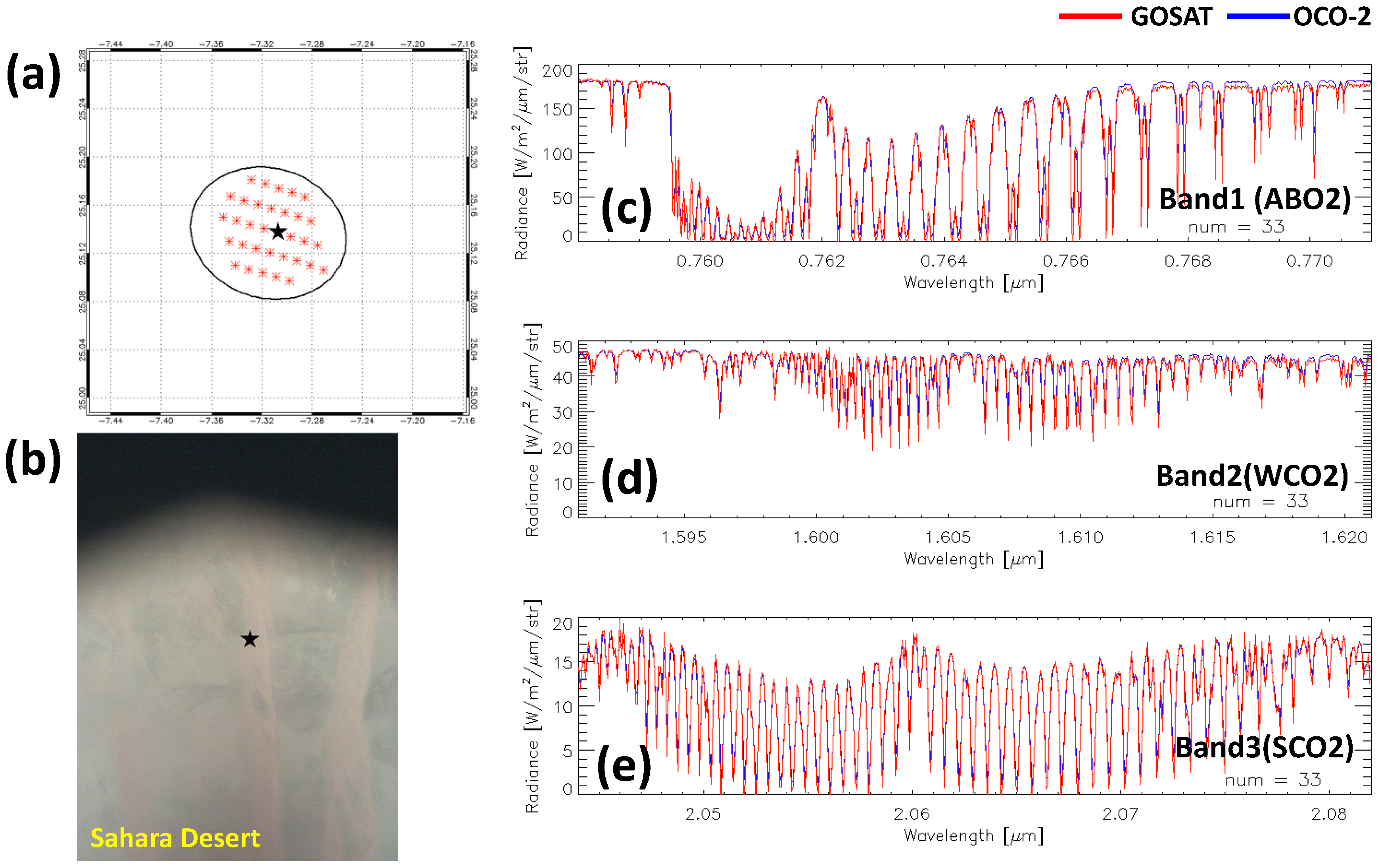
References
- Kuze, A.; Suto, H.; Shiomi, K.; Urabe, T.; Nakajima, M.; Yoshida, J.; Kawashima, T.; Yamamoto, Y.; Kataoka, F. Level 1 algorithms for TANSO on GOSAT: Processing and on-orbit calibration. Atmos. Meas. Tech. 2012, 5, 2447–2467. [Google Scholar] [CrossRef] [Green Version]
- Zhang, L.L.; Yue, T.X.; Wilson, J.P.; Wang, D.Y.; Zhao, N.; Liu, Y.; Liu, D.D.; Du, Z.P.; Wang, Y.F.; Lin, C.; et al. Modelling of XCO2 Surfaces Based on Flight Tests of TanSat. Sensors 2016, 16, 1818. [Google Scholar] [CrossRef] [PubMed]
- Veefkind, J.; Aben, I.; McMullan, K.; Förster, H.; de Vries, J.; Otter, G.; Claas, J.; Eskes, H.; de Haan, J.; Kleipool, Q.; et al. TROPOMI on the ESA Sentinel-5 precursor: A GMES mission for global observations of the atmospheric composition for climate, air quality and ozone layer applications, the Sentinel missions – new opportunities for science. Remote Sens. Environ. 2012, 120, 70–83. [Google Scholar] [CrossRef]
- Suto, H.; Kuze, A.; Shiomi, K.; Nakajima, M. Space-based carbon monitoring by GOSAT and GOSAT-2: Lessons learned from GOSAT in-orbit operation and towards better accuracy of XCO2 observation. In Proceedings of the AGU fall meeting, San Francisco, CA, USA, 9–13 December 2013. [Google Scholar]
- Orbiting Carbon Observatory-3 (OCO-3) Project Web Site. Available online: https://oco3.jpl.nasa.gov/ (accessed on 22 August 2017).
- Buchwitz, M.; Reuter, M.; Schneising, O.; Boesch, H.; Guerlet, S.; Dils, B.; Aben, I.; Armante, R.; Bergamaschi, P.; Blumenstock, T.; et al. The Greenhouse Gas Climate Change Initiative (GHG-CCI): Comparison and quality assessment of near-surface-sensitive satellite-derived CO2 and CH4 global data sets. Remote Sens. Environ. 2015, 162, 344–362. [Google Scholar] [CrossRef]
- Heymann, J.; Reuter, M.; Hilker, M.; Buchwitz, M.; Schneising, O.; Bovensmann, H.; Burrows, J.P.; Kuze, A.; Suto, H.; Deutscher, N.M.; et al. Consistent satellite XCO2 retrievals for SCIAMACHY and GOSAT using the BESD algorithm. Atmos. Meas. Tech. 2015, 8, 2961–2980. [Google Scholar] [CrossRef]
- Kuze, A.; Suto, H.; Nakajima, M.; Hamazaki, T. Thermal and near infrared sensor for carbon observation Fourier-transform spectrometer on the Greenhouse Gases Observing Satellite for greenhouse gases monitoring. Appl. Opt. 2009, 48, 6716–6733. [Google Scholar] [CrossRef] [PubMed]
- Sun, K.; Liu, X.; Nowlan, R.C.; Cai1, Z.; Chance, K.; Frankenberg, C.; Lee, A.M.R.; Pollock, R.; Rosenberg, R.; Crisp, D. Characterization of the OCO-2 instrument line shape functions using on-orbit solar measurements. Atmos. Meas. Tech. 2017, 10, 939–953. [Google Scholar] [CrossRef]
- Crisp, D.; Pollock, H.R.; Rosenberg, R.; Chapsky, L.; Lee, R.A.M.; Oyafuso, F.A.; Frankenberg, C.; O’Dell, C.W.; Bruegge, C.J.; Doran, G.B.; et al. The on-orbit performance of the Orbiting Carbon Observatory-2 (OCO-2) instrument and its radiometrically calibrated products. Atmos. Meas. Tech. 2017, 10, 59–81. [Google Scholar] [CrossRef]
- Rosenberg, R.; Maxwell, E.S.; Johnson, C.B.; Chapsky, L.; Lee, A.R.; Pollock, R. Preflight Radiometric Calibration of Orbiting Carbon Observatory 2. IEEE Trans. Geosci. Remote Sens. 2017, 5, 1994–2006. [Google Scholar] [CrossRef]
- Lee, A.R.; O’Dell, C.W.; Wunch, D.; Roehl, M.C.; Osterman, B.G.; Blavier, J.; Rosenberg, R.; Chapsky, L.; Frankenberg, C.; Hunyadi-Lay, L.S.; et al. Preflight Spectral Calibration of Orbiting Carbon Observatory 2. IEEE Trans. Geosci. Remote Sens. 2017, 5, 2499–2508. [Google Scholar] [CrossRef]
- Sakuma, F.; Bruegge, C.; Rider, D.; Brown, D.; Geier, S.; Kawakami, S.; Kuze, A. OCO-GOSAT preflight cross calibration experiment. IEEE Trans. Geosci. Remote Sens. 2010, 48, 585–599. [Google Scholar] [CrossRef]
- Kuze, A.; Taylor, T.E.; Kataoka, F.; Bruegge, C.J.; Crisp, D.; Harada, M.; Helmlinger, M.; Inoue, M.; Kawakami, S.; Kikuchi, N.; et al. Long-term vicarious calibration of GOSAT short-wave sensors: Techniques for error reduction and new estimates of radiometric degradation factors. IEEE Trans. Geosci. Remote Sens. 2014, 52, 3991–4004. [Google Scholar] [CrossRef]
- Institute for Environmental Studies (NIES) GOSAT Data Archive Service (GDAS). Available online: https://data2.gosat.nies.go.jp/ (accessed on 4 August 2017).
- NASA Goddard Earth Sciences Data and Information Services Center (GES DISC) Web Site. Available online: https://oco2.gesdisc.eosdis.nasa.gov/data/ (accessed on 14 August 2017).
- Kuze, A.; Suto, H.; Shiomi, K.; Kawakami, S.; Tanaka, M.; Ueda, Y.; Deguchi, A.; Yoshida, J.; Yamamoto, Y.; Kataoka, F.; et al. Update on GOSAT TANSO-FTS performance, operations, and data products after more than six years in space. Atmos. Meas. Tech. 2016, 9, 2445–2461. [Google Scholar] [CrossRef]
- Kuze, A.; O’Brien, D.M.; Taylor, T.E.; Day, J.O.; O’Dell, C.W.; Kataoka, F.; Yoshida, M.; Mitomi, Y.; Bruegge, C.J.; Pollock, H.; et al. Vicarious Calibration of the GOSAT Sensors Using the Railroad Valley Desert Playa. IEEE Trans. Geosci. Remote Sens. 2011, 49, 1781–1795. [Google Scholar] [CrossRef]
- Suto, H.; Yoshida, J.; Desbiens, R.; Kawashima, T.; Kuze, A. Characterization and correction of spectral distortions induced by microvibrations onboard the GOSAT Fourier transform spectrometer. Appl. Opt. 2013, 52, 4969–4980. [Google Scholar] [CrossRef] [PubMed]
- Eldering, A.; O’Dell, C.W.; Wennberg, P.O.; Crisp, D.; Gunson, M.R.; Viatte, C.; Avis, C.; Braverman, A.; Castano, R.; Chang, A.; et al. The Orbiting Carbon Observatory-2: First 18 months of science data products. Atmos. Meas. Tech. 2017, 10, 549–563. [Google Scholar] [CrossRef]
- O’Dell, C.W.; Connor, B.; Bösch, H.; O’Brien, D.; Frankenberg, C.; Castano, R.; Christi, M.; Eldering, D.; Fisher, B.; Gunson, M.; et al. The ACOS CO2 retrieval algorithm—Part 1: Description and validation against synthetic observations. Atmos. Meas. Tech. 2012, 5, 99–121. [Google Scholar] [CrossRef]
- Crisp, D.; Fisher, B.M.; O’Dell, C.W.; Frankenberg, C.; Basilio, R.; Bösch, H.; Brown, L.R.; Castano, R.; Connor, B.; Deutscher, N.M.; et al. The ACOS XCO2 retrieval algorithm, Part 2: Global XCO2 data characterization. Atmos. Meas. Tech. 2012, 5, 687–707. [Google Scholar] [CrossRef]
- Osterman, G.; Eldering, A.; Cheng, C.; O’Dell, C.; Crisp, D.; Frankenberg, C.; Fisher, B. ACOS Level 2 Standard Product and Lite Data Product Data User’s Guide, v7.3. Available online: https://docserver.gesdisc.eosdis.nasa.gov/public/project/OCO/ACOS%20v7.3_DataUsersGuide-RevE.pdf (accessed on 3 August 2017).
- Bösch, H.; Brown, L.; Castano, R.; Christi, M.; Connor, B.; Crisp, D.; Eldering, A.; Fisher, B.; Frankenberg, C.; Gunson, M.; et al. Orbiting Carbon Observatory (OCO)-2 Level 2 Full Physics Retrieval Algorithm Theoretical Basis Document. Available online: https://docserver.gesdisc.eosdis.nasa.gov/public/project/OCO/OCO2_L2_ATBD.V6.pdf (accessed on 6 October 2017).
- Toon, G.C.; Blavier, J.-F.; Sen, B.; Salawitch, R.J.; Osterman, G.B.; Notholt, J.; Rex, M.; McElroy, C.T.; Russell, J.M., III. Ground-based observations of Arctic O3 loss during spring and summer 1997. J. Geophys. Res. 1999, 104, 26497–26510. [Google Scholar] [CrossRef]
- Thuillier, G.; Hers´e, M.; Labs, D.; Foujols, T.; Peetermans, W.; Gillotay, D.; Simon, P.C.; Mandel, H. The Solar Spectral Irradiance from 200 to 2400 nm as Measured by the SOLSPEC Spectrometer from the Atlas and Eureca Missions. Solar Phys. 2003, 214, 1–22. [Google Scholar] [CrossRef]
- Wunch, D.; Wennberg, P.O.; Toon, G.C.; Connor, B.J.; Fisher, B.; Osterman, G.B.; Frankenberg, C.; Mandrake, L.; O’Dell, C.; Ahonen, P.; et al. A method for evaluating bias in global measurements of CO2 total columns from space. Atmos. Chem. Phys. 2011, 11, 12317–12337. [Google Scholar] [CrossRef]
- Lindqvist, H.; O’Dell, C.W.; Basu, S.; Boesch, H.; Chevallier, F.; Deutscher, N.; Feng, L.; Fisher, B.; Hase, F.; Inoue, M.; et al. Does GOSAT capture the true seasonal cycle of carbon dioxide? Atmos. Chem. Phys. 2015, 15, 13023–13040. [Google Scholar] [CrossRef]
- Kulawik, S.; Wunch, D.; O’Dell, C.; Frankenberg, C.; Reuter, M.; Oda, T.; Chevallier, F.; Sherlock, V.; Buchwitz, M.; Osterman, G.; et al. Consistent evaluation of ACOS-GOSAT, BESD-SCIAMACHY, CarbonTracker, and MACC through comparisons to TCCON. Atmos. Meas. Tech. 2016, 9, 683–709. [Google Scholar] [CrossRef]
- Wunch, D.; Wennberg, P.O.; Osterman, G.; Fisher, B.; Naylor, B.; Roehl, C.M.; O’Dell, C.; Mandrake, L.; Viatte, C.; Kiel, M.; et al. Comparisons of the Orbiting Carbon Observatory-2 (OCO-2) XCO2 measurements with TCCON. Atmos. Meas. Tech. 2017, 10, 2209–2238. [Google Scholar] [CrossRef]
- Taylor1, E.T.; O’Dell1, W.C.; Frankenberg, C.; Partain, T.P.; Cronk, Q.H.; Savtchenko, A.; Nelson, N.R.; Rosenthal, J.E.; Chang, Y.A.; Fisher, B.; et al. Orbiting Carbon Observatory-2 (OCO-2) cloud screening algorithms: Validation against collocated MODIS and CALIOP data. Atmos. Meas. Tech. 2016, 9, 973–989. [Google Scholar]
- MODIS BRDF-Albedo Model Parameters 16-Day L3 Global 1km (MCD43B1). Available online: https://lpdaac.usgs.gov/dataset_discovery/modis/modis_products_table/mcd43b1 (accessed on 14 August 2017).
- Strahler, A.H.; Muller, J.-P. MODIS BRDF/Albedo Product: Algorithm Theoretical Basis Document Version 5.0. 1999. Available online: http://citeseerx.ist.psu.edu/viewdoc/download?doi=10.1.1.133.7683&rep=rep1&type=pdf (accessed on 10 November 2017).
- O’Brien, D.; Polonsky, I.; O’Dell, C.W.; Kuze, A.; Kikuchi, N.; Yoshida, Y.; Natraj, V. Testing the polarization model for TANSO-FTS on GOSAT against clear-sky observations of sun-glint over ocean. IEEE Trans. Geosci. Remote Sens. 2013, 51, 5199–5209. [Google Scholar] [CrossRef]
- Kikuchi, N.; Yoshida, Y.; Uchino, O.; Morino, I.; Yokota, T. An advanced retrieval algorithm for greenhouse gases using polarization information measured by GOSAT TANSO-FTS SWIR I: Simulation study. J. Geophys. Res. 2016, 121, 13129–13157. [Google Scholar] [CrossRef]
- OCO-2 Warn Level, Bias Correction, and Lite File Product Description; Version 1.1; 30 June 2016. Available online: https://co2.jpl.nasa.gov/static/docs/OCO2_XCO2_Lite_Files_and_Bias_Correction_0716.docx (accessed on 10 November 2017).
- Frankenberg, C.; Butz, A.; Toon, G.C. Disentangling chlorophyll fluorescence from atmospheric scattering effects in O2 A-band spectra of reflected sun-light. Geophys. Res. Lett. 2011, 38, L03801. [Google Scholar] [CrossRef]
- NASA AERONET (AErosol RObotic NETwork) Program Web Site. Available online: https://aeronet.gsfc.nasa.gov/ (accessed on 14 August 2017).
- Jicheng, L.; Crystal, S.; Alan, S.; Ziti, J.; Yanmin, S.; Qingling, Z.; Miguel, R.; John, A.A.; Ellsworth, G.D. Validation of Moderate Resolution Imaging Spectroradiometer (MODIS) albedo retrieval algorithm: Dependence of albedo on solar zenith angle. J. Geophys. Res. 2009, 114, D01106. [Google Scholar] [CrossRef]
- Miller, C.E.; Crisp, D.; DeCola, P.L.; Olsen, S.C.; Randerson, J.T.; Michalak, A.M.; Alkhaled, A.; Rayner, P.; Jacob, D.J.; Suntharalingam, P.; et al. Precision requirements for space-based XCO2 data. J. Geophys. Res. 2007, 112, D10314. [Google Scholar] [CrossRef]
- Shiomi, K.; Kuze, A.; Hashimoto, M.; Suto, H.; Kataoka, F.; Igarashi, T.; Kawakami, S. Calibration and validation activities for GOSAT collaborated with OCO-2. In Proceedings of the 31st International Symposium on Space Technology and Science, Matsuyama, Japan, 3–9 June 2017. [Google Scholar]

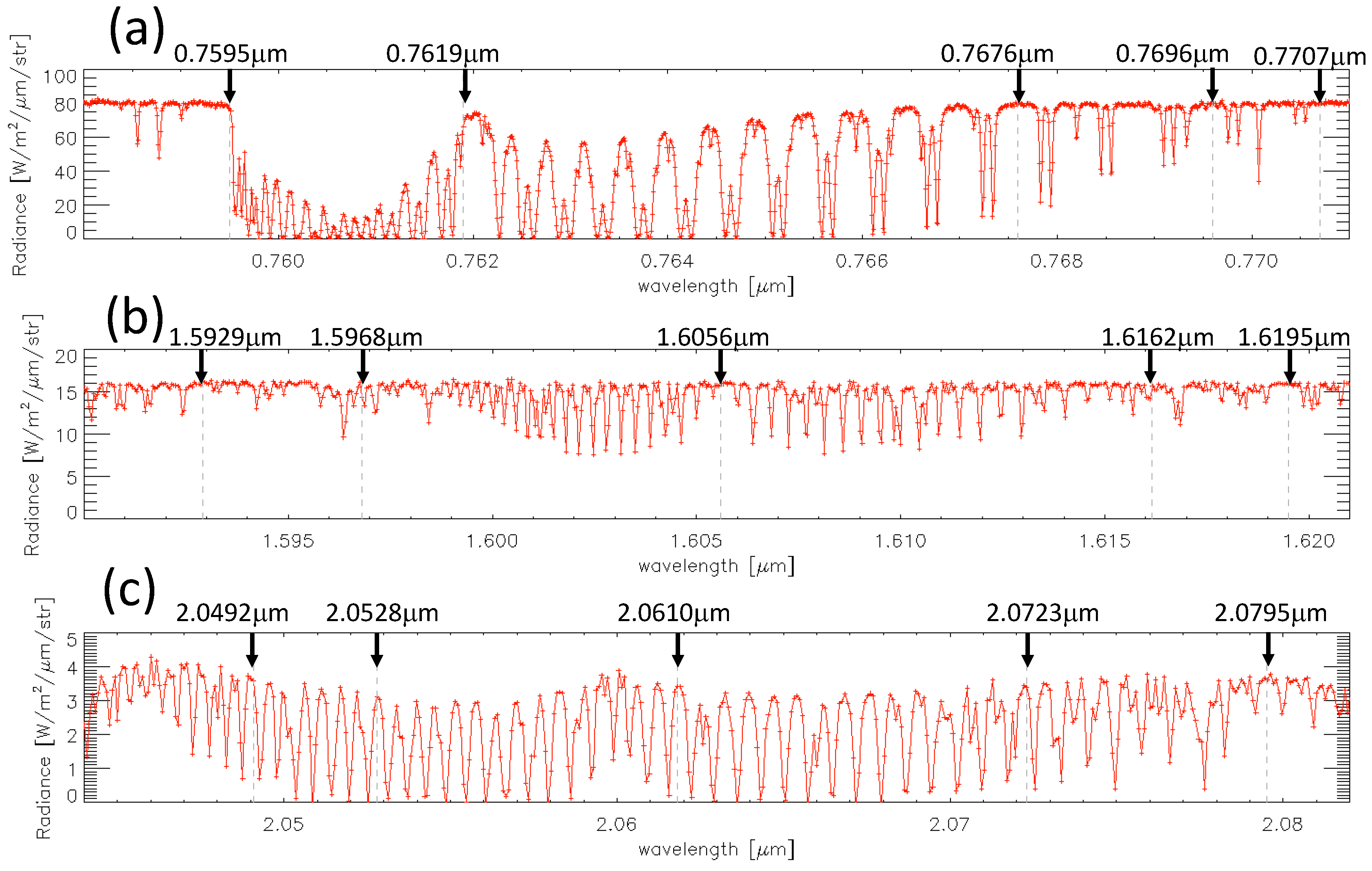

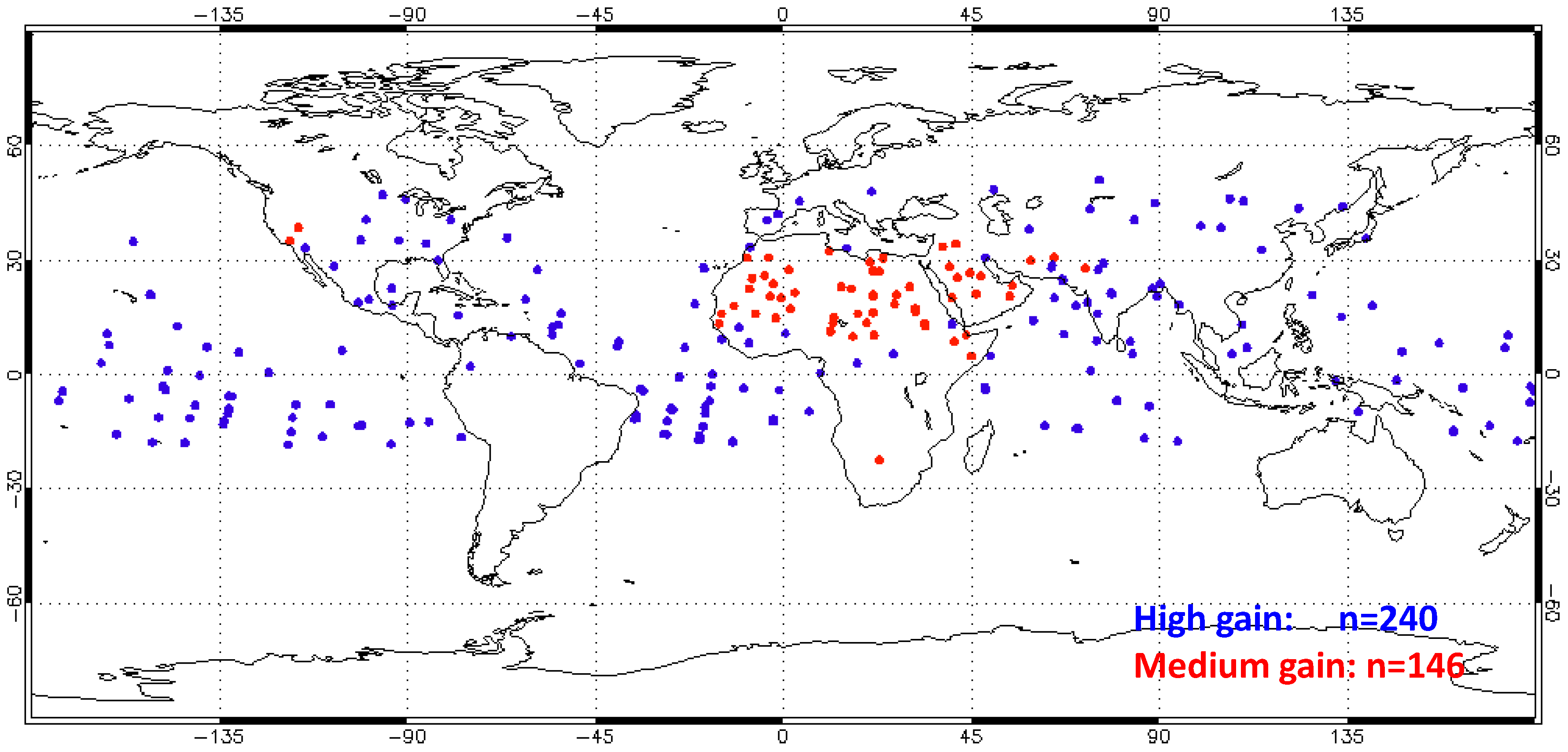


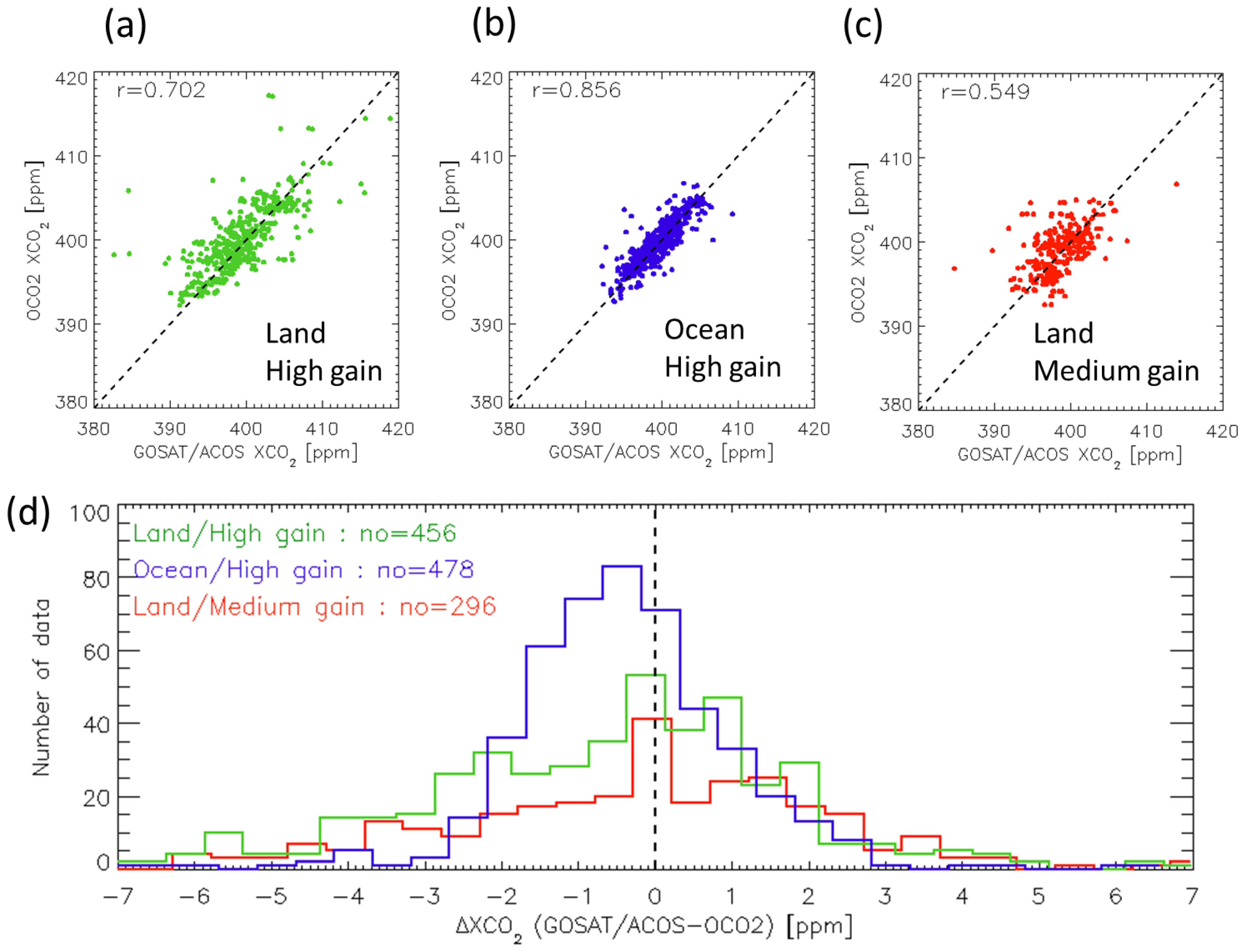
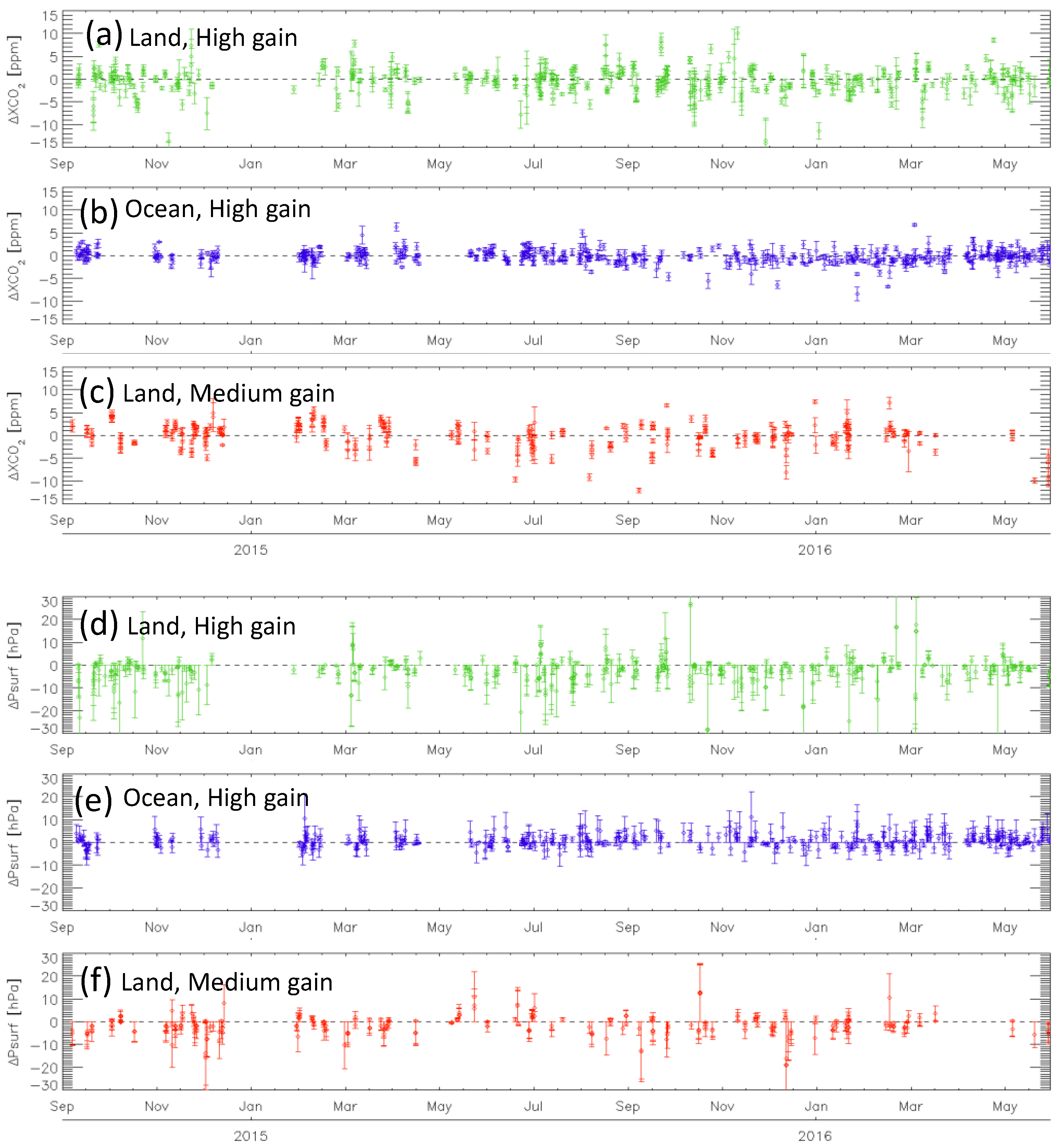
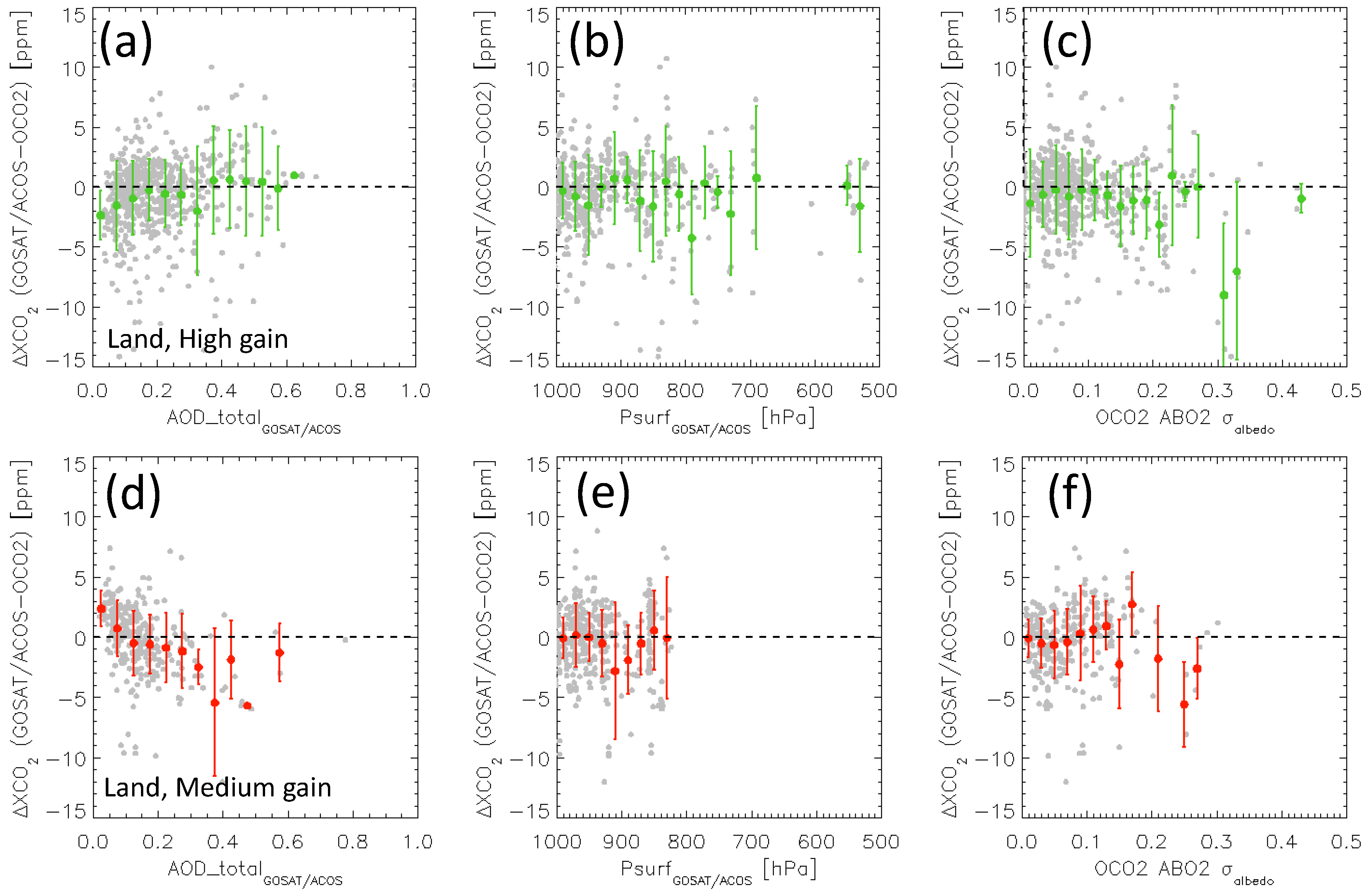
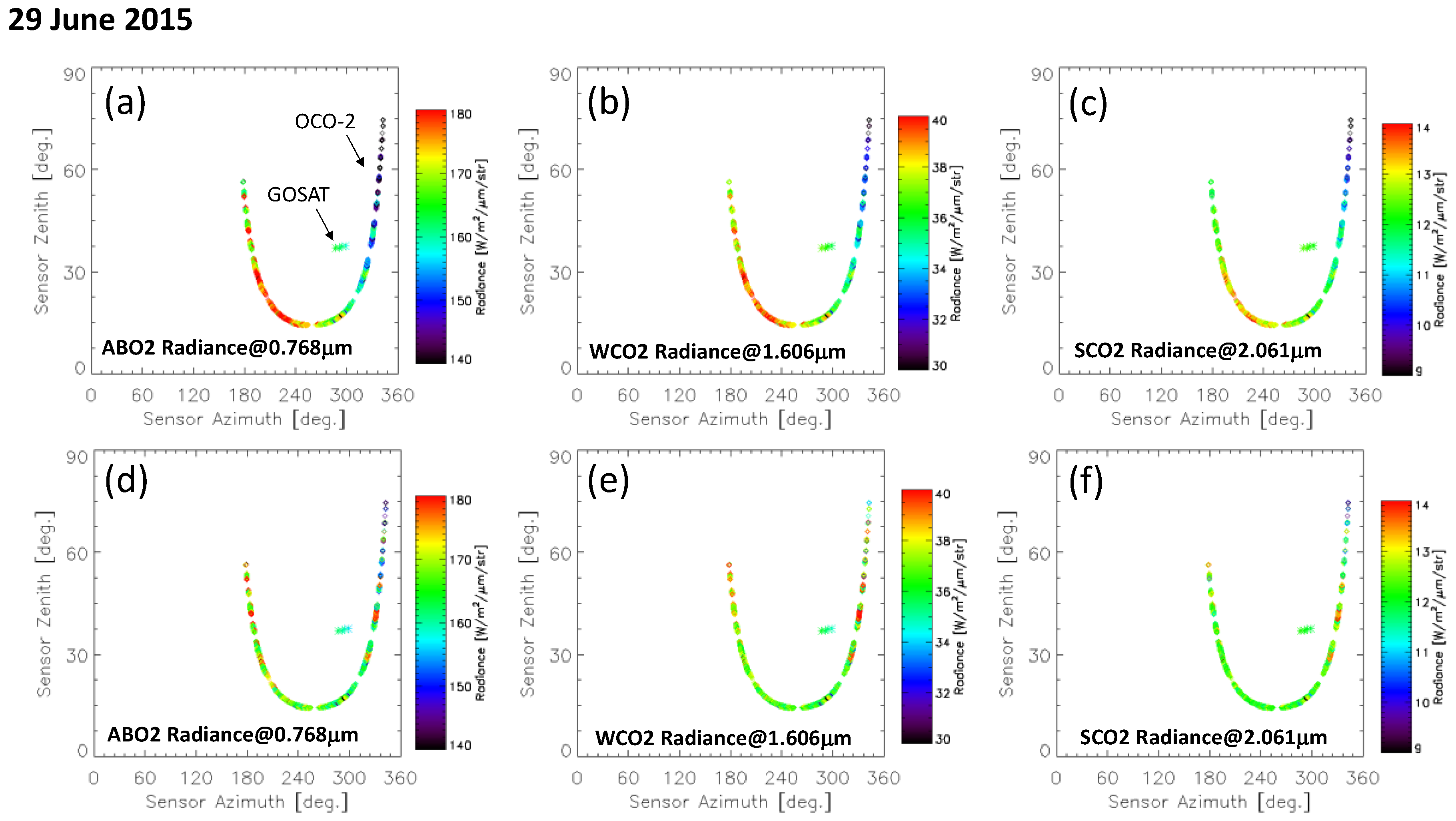
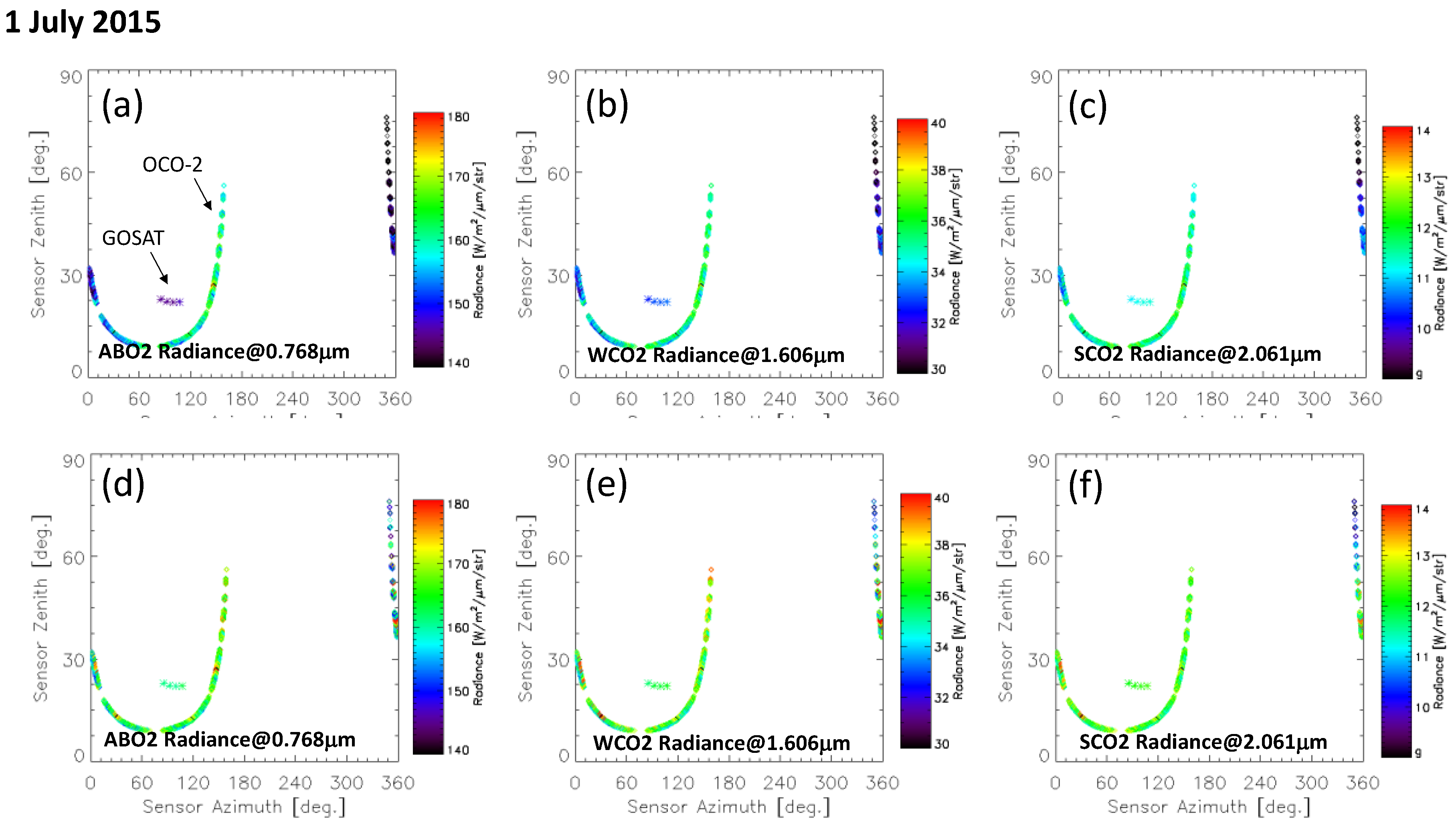
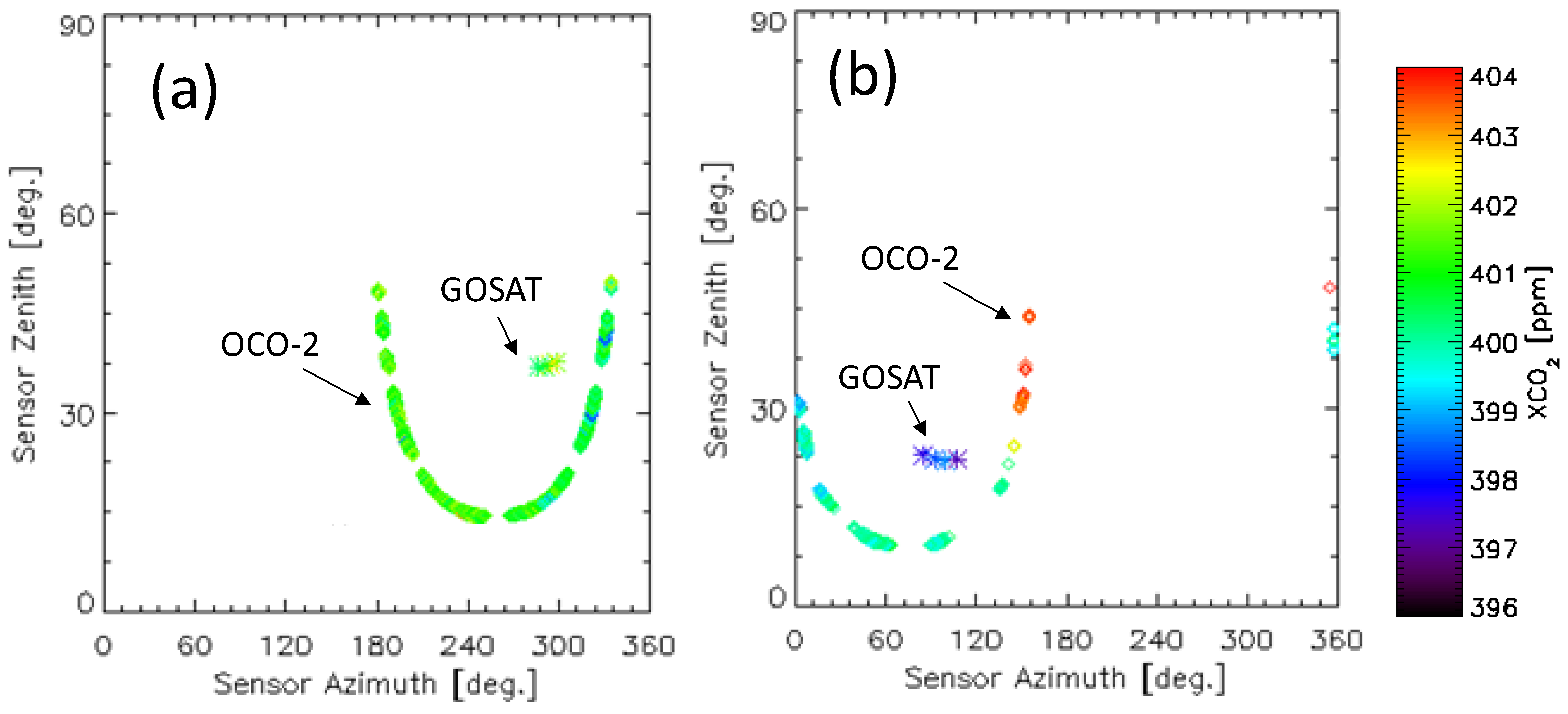
| Satellite | GOSAT | OCO-2 | |
|---|---|---|---|
| Spectrometer Type | Michelson Fourier transform | Grating | |
| Band 1 (ABO2) | Spectral Range | 758–775 nm | 758–772 nm |
| Sampling Interval | 0.2 cm−1/0.011–0.012 nm | 0.015 nm | |
| FWHM | 0.02 nm | 0.04 nm | |
| Band 2 (WCO2) | Spectral Range | 1560–1720 nm | 1594–1619 nm |
| Sampling Interval | 0.2 cm−1/0.045–0.064 nm | 0.031 nm | |
| FWHM | 0.06 nm | 0.08 nm | |
| Band 3 (SCO2) | Spectral Range | 1920–2080 nm | 2042–2082 nm |
| Sampling Interval | 0.2 cm−1/0.069–0.090 nm | 0.04 nm | |
| FWHM | 0.10 nm | 0.10 nm | |
| Polarization | Two linear (P and S) | One linear |
| Satellite | GOSAT | OCO-2 |
|---|---|---|
| Orbit Height | 666 km | 705 km |
| Inclination | 98.1 degrees | 98.2 degrees |
| Local Time | 12:46–12:55 LT | 13:35:30–13:36:20 LT |
| Recurrent Period | 3 day | 16 day |
| Repeat Orbits | 44 | 233 |
| Swath | 35 degrees | 10.6 km (nadir) |
| Pointing | Multiple targets with a 2-axis pointing mechanism | Nadir, Glint, Transition or Target |
| Footprint (Nadir, Nominal) | Circle of 10.5 km diameter | Parallelogram of 1.29 km × 2.25 km |
| Raw and BRDF Corrected Radiance (W/m2/µm/str) | |||||||
|---|---|---|---|---|---|---|---|
| 29 June 2015 | 1 July 2015 | ||||||
| 0.768 µm | 1.606 µm | 2.061 µm | 0.768 µm | 1.606 µm | 2.061 µm | ||
| OCO-2 (Averaged) | non-BRDF | 164.02 | 36.41 | 12.07 | 151.99 | 33.60 | 11.03 |
| BRDF-corr | 164.89 | 36.64 | 12.20 | 161.85 | 35.78 | 11.93 | |
| BRDF-corr + ZN < 55 deg | 165.80 | 36.70 | 12.27 | 162.57 | 35.91 | 12.04 | |
| BRDF-corr + ZN < GOSAT_ZN | 165.58 | 36.52 | 12.23 | 162.33 | 35.71 | 12.01 | |
| GOSAT | non-BRDF | 161.38 | 36.32 | 12.25 | 145.43 | 32.95 | 11.22 |
| BRDF-corr | 159.36 | 35.35 | 12.04 | 161.31 | 35.82 | 12.21 | |
| Raw and BRDF Corrected Radiance std/ave (%) | |||||||
|---|---|---|---|---|---|---|---|
| 29 June 2015 | 1 July 2015 | ||||||
| 0.768 µm | 1.606 µm | 2.061 µm | 0.768 µm | 1.606 µm | 2.061 µm | ||
| OCO-2 (Averaged) | non-BRDF | 8.76 | 6.94 | 8.88 | 6.77 | 6.03 | 8.45 |
| BRDF-corr | 5.03 | 3.96 | 5.08 | 4.89 | 5.26 | 6.75 | |
| BRDF-corr + ZN < 55 deg | 4.49 | 3.75 | 4.27 | 4.46 | 4.89 | 5.61 | |
| BRDF-corr + ZN < GOSAT_ZN | 3.55 | 3.66 | 3.66 | 3.63 | 4.31 | 4.99 | |
| GOSAT | non-BRDF | 1.49 | 1.43 | 1.07 | 0.62 | 0.78 | 0.72 |
| BRDF-corr | 1.49 | 1.43 | 1.07 | 0.62 | 0.78 | 0.72 | |
© 2017 by the authors. Licensee MDPI, Basel, Switzerland. This article is an open access article distributed under the terms and conditions of the Creative Commons Attribution (CC BY) license (http://creativecommons.org/licenses/by/4.0/).
Share and Cite
Kataoka, F.; Crisp, D.; Taylor, T.E.; O’Dell, C.W.; Kuze, A.; Shiomi, K.; Suto, H.; Bruegge, C.; Schwandner, F.M.; Rosenberg, R.; et al. The Cross-Calibration of Spectral Radiances and Cross-Validation of CO2 Estimates from GOSAT and OCO-2. Remote Sens. 2017, 9, 1158. https://doi.org/10.3390/rs9111158
Kataoka F, Crisp D, Taylor TE, O’Dell CW, Kuze A, Shiomi K, Suto H, Bruegge C, Schwandner FM, Rosenberg R, et al. The Cross-Calibration of Spectral Radiances and Cross-Validation of CO2 Estimates from GOSAT and OCO-2. Remote Sensing. 2017; 9(11):1158. https://doi.org/10.3390/rs9111158
Chicago/Turabian StyleKataoka, Fumie, David Crisp, Thomas E. Taylor, Chris W. O’Dell, Akihiko Kuze, Kei Shiomi, Hiroshi Suto, Carol Bruegge, Florian M. Schwandner, Robert Rosenberg, and et al. 2017. "The Cross-Calibration of Spectral Radiances and Cross-Validation of CO2 Estimates from GOSAT and OCO-2" Remote Sensing 9, no. 11: 1158. https://doi.org/10.3390/rs9111158





